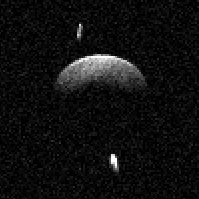Once considered just your average single asteroid, 2001 SN263 has now been revealed as the first near-Earth triple asteroid ever found. The asteroid, with three bodies orbiting each other, was discovered this week by astronomers at the sensitive radar telescope at Cornell University’s Arecibo Observatory in Puerto Rico.
Cornell University and Arecibo astronomer Michael C. Nolan says he and his colleagues made the discovery when they obtained radar images February 11. The group subsequently took more images to learn that the three objects, about 7 million miles from Earth, are rotating around each other.
The main, central body is spherical with a diameter of roughly 1.5 miles (2 kilometers), while the larger of the two moons is about half that size. The smallest object is about 1,000 feet across, or about the size of the Arecibo telescope.
Other triple asteroids exist in the asteroid belt (between Mars and Jupiter) and beyond, but this is the first near-Earth system where the actual shapes of objects can be clearly seen.
“This discovery has extremely important implications for ideas about the origins of near-Earth asteroids and the processes responsible for their physical properties,” says Nolan. “Double, or binary, asteroid systems are known to be fairly common, about one in six near-Earth asteroids is a binary, but this is the first near-Earth triple system to be discovered.”
The object was first discovered visually September 19, 2001, by the Lincoln Near Earth Asteroid Research (LINEAR) project, part of the Massachusetts Institute of Technology’s Lincoln Laboratory. The orbits of binary, and now triple, asteroid systems unveil the mass and allow astronomers to assess whether they are stable over millennia or have formed very recently. Previous radar investigations of binary near-Earth asteroids have disclosed extraordinary physical and dynamical characteristics.
Nolan said this discovery prompts several important questions: Are the objects orbiting in the same plane? How rapidly are the orbits changing with time? Did the moons form when this asteroid formed in the main asteroid belt, or after it arrived in near-Earth space?
Because of the small sizes and irregularly shaped components, 2001 SN263 should offer unique insights relative to the much larger triple systems in the main asteroid belt, says Nolan. “Examining the orbits of the moons as we continue to observe 2001 SN263 over the next few weeks may allow us to determine the density of the asteroid and type of material from which it is made,” he says. “We will also be studying its shape, surface features and regolith [blanketing material] properties.”










